
9,159 wildfires were active in the US state of California during 2009. The fires burned more than 422,147 acres of land from early February through late November, due to Red Flag conditions, destroying hundreds of structures, injuring 134 people, and killing four. The wildfires also caused at least US$134.48 million in damage. Although the fires burned many different regions of California in August, the month was especially notable for several very large fires which burned in Southern California, despite being outside of the normal fire season for that region.

2014 saw several notable wildfires igniting in California, especially during the month of May, when multiple fires were ablaze concurrently in Southern California, and during September, when several massive wildfires were burning in Northern California. In the context of the 2012–13 North American drought, as well as powerful Santa Ana winds, weather conditions were ideal for wildfires. A total of 7,865 wildfires ignited throughout the year, which burned at least 625,540 acres (2,531.5 km2) of land. The wildfires caused a total of 146 injuries and 2 fatalities, in addition to causing at least $204.05 million in damage.
The Poinsettia Fire was the second most destructive of the May 2014 San Diego County wildfires. It caused property damage estimated at $22.5 million, as well as the only reported fatality in the San Diego County series of wildfires. As of July 10, 2014, the cause of the fire is listed as "undetermined", which allows for further investigation if more information comes to light.
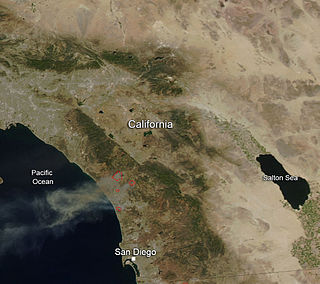
The May 2014 San Diego County wildfires were a swarm of 20 wildfires that erupted during May 2014, in San Diego County, California, during severe Santa Ana Wind conditions, historic drought conditions, and a heat wave. The main event during mid-May was preceded by a precursor fire that ignited on May 5. The Bernardo Fire has been declared accidental, and officials believe the Cocos Fire was intentionally set. The causes of the other fires are still under investigation by multiple agencies, and a joint task force was formed to coordinate the investigations and facilitate communications. Six injuries and one fire-related fatality were reported.
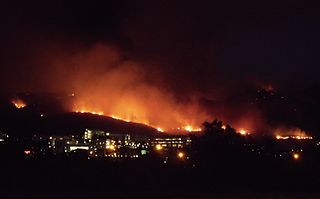
Cocos Fire, originally known as the Twin Oaks Fire, was a wildfire that ignited on May 14, 2014 in San Marcos, California, in the hills south of California State University, San Marcos. The Cocos Fire quickly spread into western Escondido. The fire destroyed more than 40 buildings, including a dozen single-family homes. The Harmony Grove Spiritualist Association, a 13-acre spiritualist retreat founded in 1896, was particularly hard hit; most of the buildings and residences on the property were destroyed, and the association's president said, "We're pretty much wiped out." Property damage from the fire is estimated at more than $5.7 million. Three minor injuries have been reported. The Cocos Fire was the last of the May 2014 wildfires in San Diego County to be extinguished, with full containment on May 22, 2014.
The Bully Fire was a wildfire in Shasta County.
The Wall Fire was a wildfire in 2017 near Bangor in Eastern Butte County, in California, in the United States. Named for its ignition point near Chinese Wall Road, it was reported at 2:52 PM PDT on July 7, 2017. The fire was contained on July 17, 2017, and burned a total of 6,033 acres (2,441 ha).
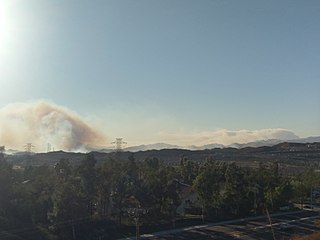
The Rye Fire was a wildfire that burned in Santa Clarita, California, in the United States, and one of multiple wildfires that broke out across Southern California in December 2017. The fire threatened over 5,000 structures, including Six Flags Magic Mountain, threatened the city of Santa Clarita and impacted traffic on Interstate 5. The Rye Fire burned a total of 6,049 acres (24.48 km2), before it was fully contained on December 12. The fire destroyed six buildings, including minor structures located at the Peter J. Pitchess Detention Center.
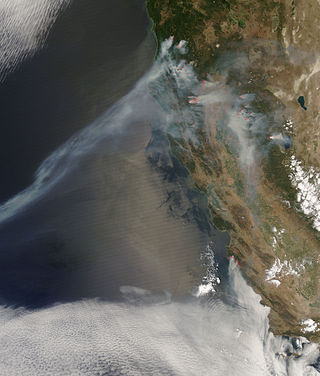
The Klamath Theater Complex Fire, also known as the Bear Wallow Complex Fire, was the largest wildfire of the 2008 California wildfire season. The complex fire originated as 11 separate wildfires, before merging into a single massive complex fire that burned 192,038 acres (777.15 km2) in Northern California, and lasted for over 3 months. The progenitor fires of the fire complex were all caused by lightning. As of 2024, the Klamath Theater Complex Fire was the 19th largest fire in modern California history. The complex fire killed a total of two firefighters.

The Pawnee Fire was a large wildfire that burned in Spring Valley in Lake County, California, in the United States. The fire started on June 23, 2018, and quickly expanded overnight, destroying 12 structures, and causing the evacuation of the entire Spring Valley area. It destroyed 22 structures, damaged six structures, and burned a total of 15,185 acres (61 km2) before it was fully contained on July 8, 2018. A Cal Fire investigation determined in April 2019 the cause of the fire was target shooting.

The Klamathon Fire was a wildfire in Siskiyou County south of Hornbrook, California in the United States. The fire was reported on July 5, 2018 and was contained on July 21, after burning 38,008 acres (154 km2). The fire threatened private timber lands along the California-Oregon border; public lands in the Klamath National Forest; Rogue River-Siskiyou National Forest; Jackson County, Oregon; communities of Hornbrook and Hilt, California; and Colestin, Oregon. It destroyed 82 structures, damaged 12 structures, injured three firefighters, and killed one civilian.

The Natchez Fire was a wildfire that burned near the California and Oregon border in Siskiyou County, California, in the United States. The Natchez Fire began on July 15, 2018, due to lightning, and the fire burned a total of 38,134 acres before it was fully contained on October 30, 2018.
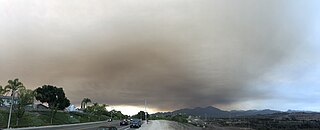
The Holy Fire was a wildfire that burned in the Cleveland National Forest in Orange and Riverside Counties, California. The wildfire started on August 6, 2018, at around 1:15 PM PDT, in the vicinity of Trabuco Canyon. A suspected arsonist was booked into the Orange County jail in Santa Ana, California but found not guilty in 2023. The blaze burned 23,136 acres (94 km2) and destroyed 18 buildings, before it was fully contained on September 13, 2018. While the fire was actively spreading in early and mid-August, residents of the nearby cities of Corona, Temescal Valley, and Lake Elsinore were placed under evacuation orders.

The Crews Fire was a wildfire that burned east of the city of Gilroy in Santa Clara County, California, in the United States. The fire started on July 5, 2020. It burned 5,513 acres (2,231 ha) and was extinguished on July 13, 2020. Burning approximately three miles east of Highway 101, the fire caused the evacuation approximately 20 homes and 70 residents. One structure was destroyed, one was damaged, and one firefighter was injured. It threatened 30 structures and farm and ranch lands in southeast Gilroy in the San Juan Valley. Mandatory evacuations were ordered on July 5, and they were lifted on July 8.

The Red Salmon Complex was a wildfire that burned 144,698 acres (58,557 ha) in Humboldt, Trinity, and Siskiyou County in Northern California during the 2020 California wildfire season. On July 27, lightning strikes in the Trinity Alps Wilderness started two fires, the Salmon Fire and the Red Fire, which eventually merged. As the fire grew, hazardous smoke levels surrounded Forks of Salmon, Orleans, Yreka, and Weed.

The Lava Fire was a wildfire that burned 26,409 acres (10,687 ha) along the slopes of Mount Shasta near Weed, California during the 2021 California wildfire season. The fire started on June 25, 2021 and was fully contained on September 3, 2021. The fire destroyed 23 buildings, including 14 houses, as well as damaged an additional building.
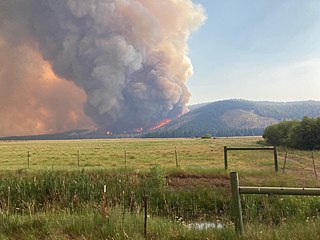
The Tennant Fire was a wildfire that burned in the Klamath National Forest in Siskiyou County, California, in the United States as part of the 2021 California wildfire season. The fire was first reported just east of Highway 97, three miles northwest of Bray, California on June 28, 2021. The fire was contained on July 12, 2021. The fire burned 10,580 acres (4,282 ha), destroyed five structures, and caused evacuations in Macdoel, California. The cause remains under investigation. The Tennant Fire was one of three fires burning at the same time in the Lake Shasta region, the others being the Lava Fire and the Salt Fire.

The Fawn Fire was a destructive wildfire in Northern California's Shasta County, near Redding, in late September and early October 2021. The fire, which was caused by an alleged act of arson, ignited on September 22 in mountains to the northeast of Redding. High winds the following day drove the fire south and west into neighborhoods in the wildland-urban interface, where it destroyed 185 buildings and damaged 26 more. At least three firefighters were injured. The Fawn Fire cost more than $25 million to suppress and burned 8,578 acres before being fully contained on October 2. A woman was arrested the day of the Fawn Fire's ignition and charged with starting the fire. As of 2024, legal proceedings remained ongoing.
The Mill Fire was a fast-moving, deadly and destructive wildfire that burned during the 2022 California wildfire season, destroying parts of the communities of Weed, Lake Shastina and Edgewood in Siskiyou County in the U.S. state of California. Igniting during hot, dry & windy conditions on September 2, 2022, amid a record-breaking heat wave that spanned much of the state, the Mill Fire moved rapidly to the north. Most of the fire's acreage burned and structures destroyed occurred on the first day, due to its predominantly wind-driven nature. The Mill Fire burned 3,935 acres, destroyed 118 structures, and damaged 26 more. The fire also caused 2 fatalities when two residents of Weed were unable to escape the quick-moving blaze in its first hours. The fire was fully contained on September 13, 2022.

The Bridge Fire was a destructive wildfire in the Angeles National Forest in Southern California's Los Angeles and San Bernardino counties. The fire began on September 8 and burned a total of 56,030 acres before being fully contained on November 26, 2024. The cause of the fire is under investigation. It was the third-largest wildfire of California's 2024 fire season. The fire threatened the areas of Wrightwood, Mount Baldy Village and Jackson Lake, where mandatory evacuation orders were in place. The fire affected nearly 100 structures total.

















